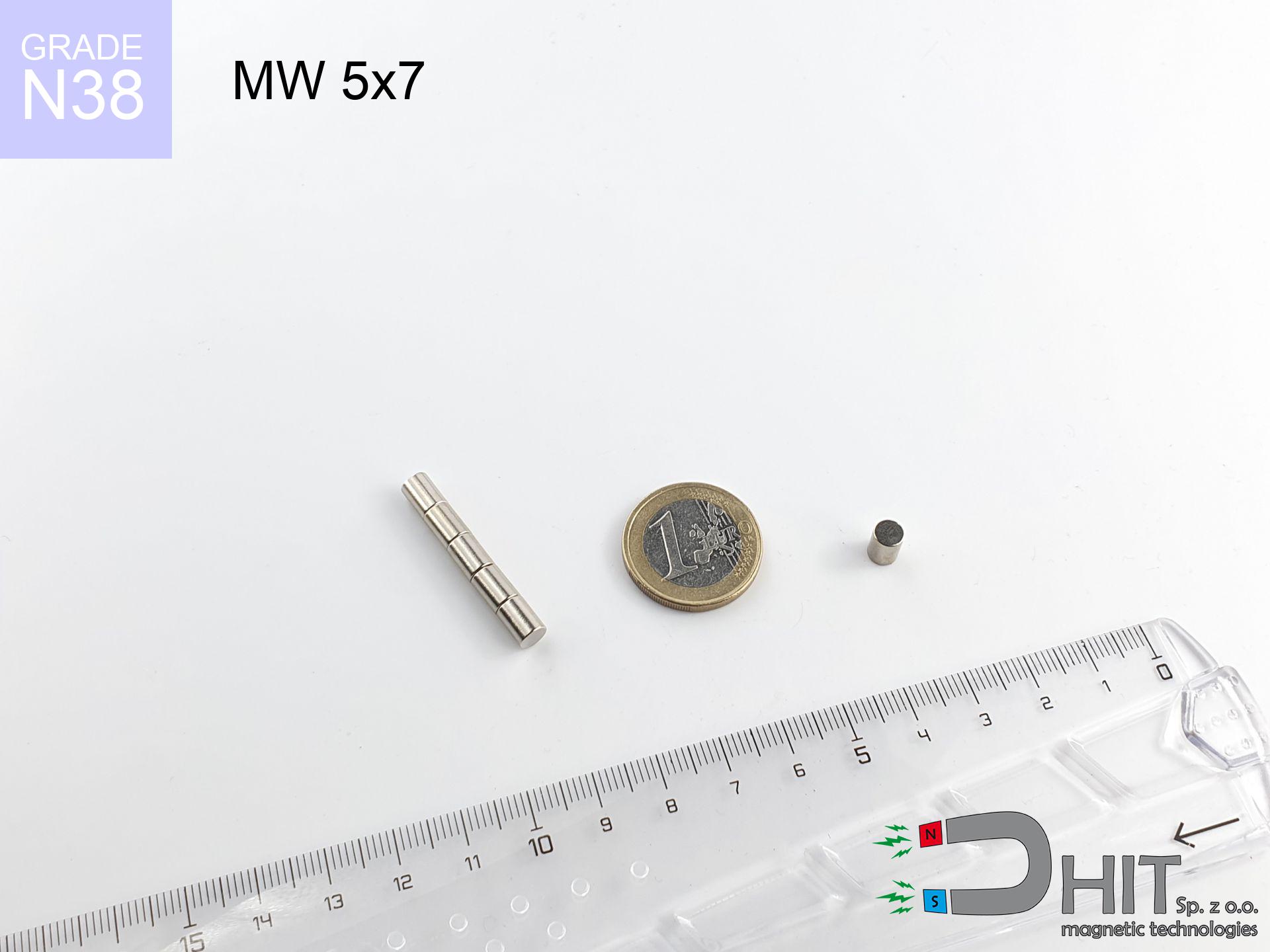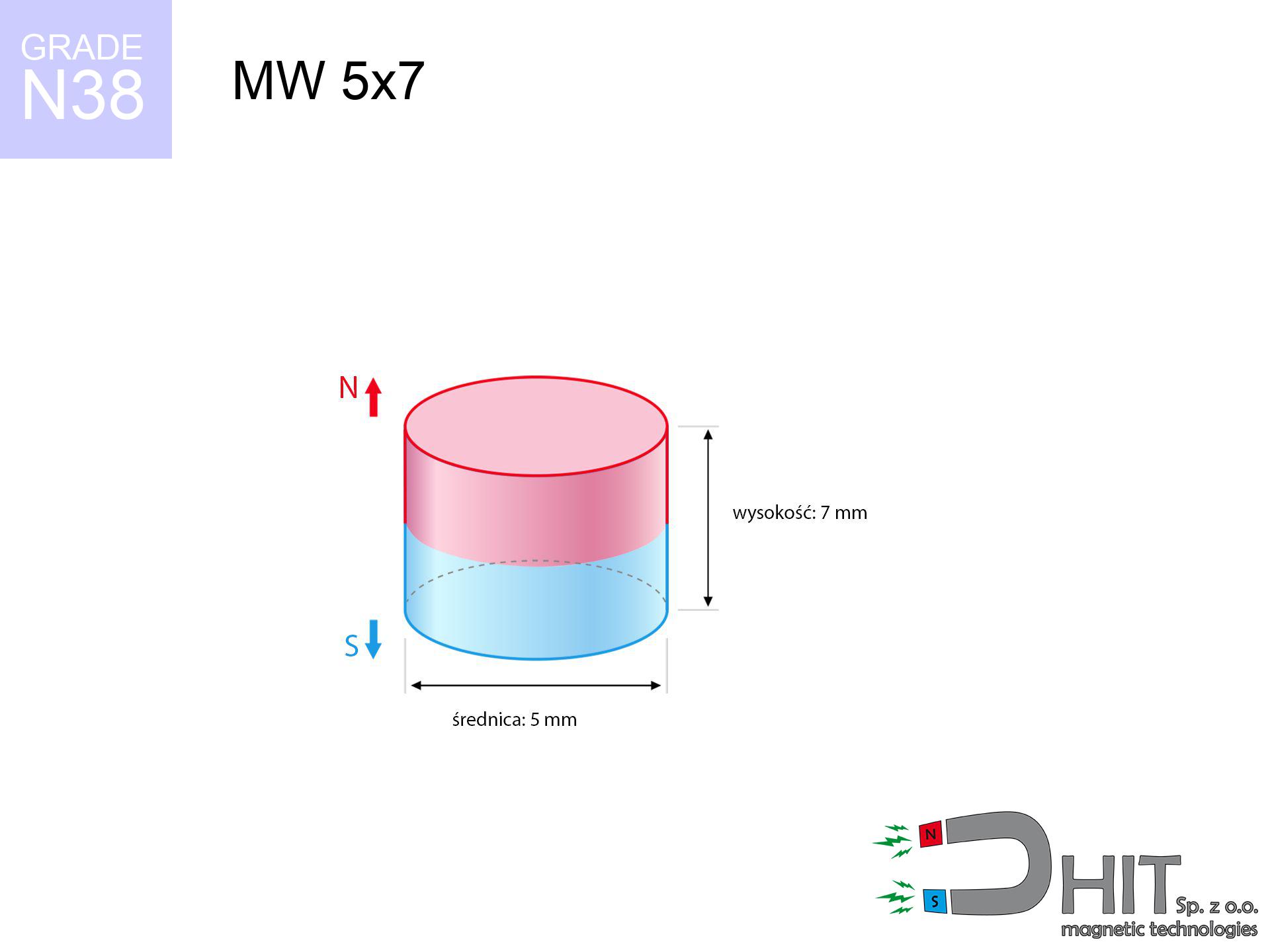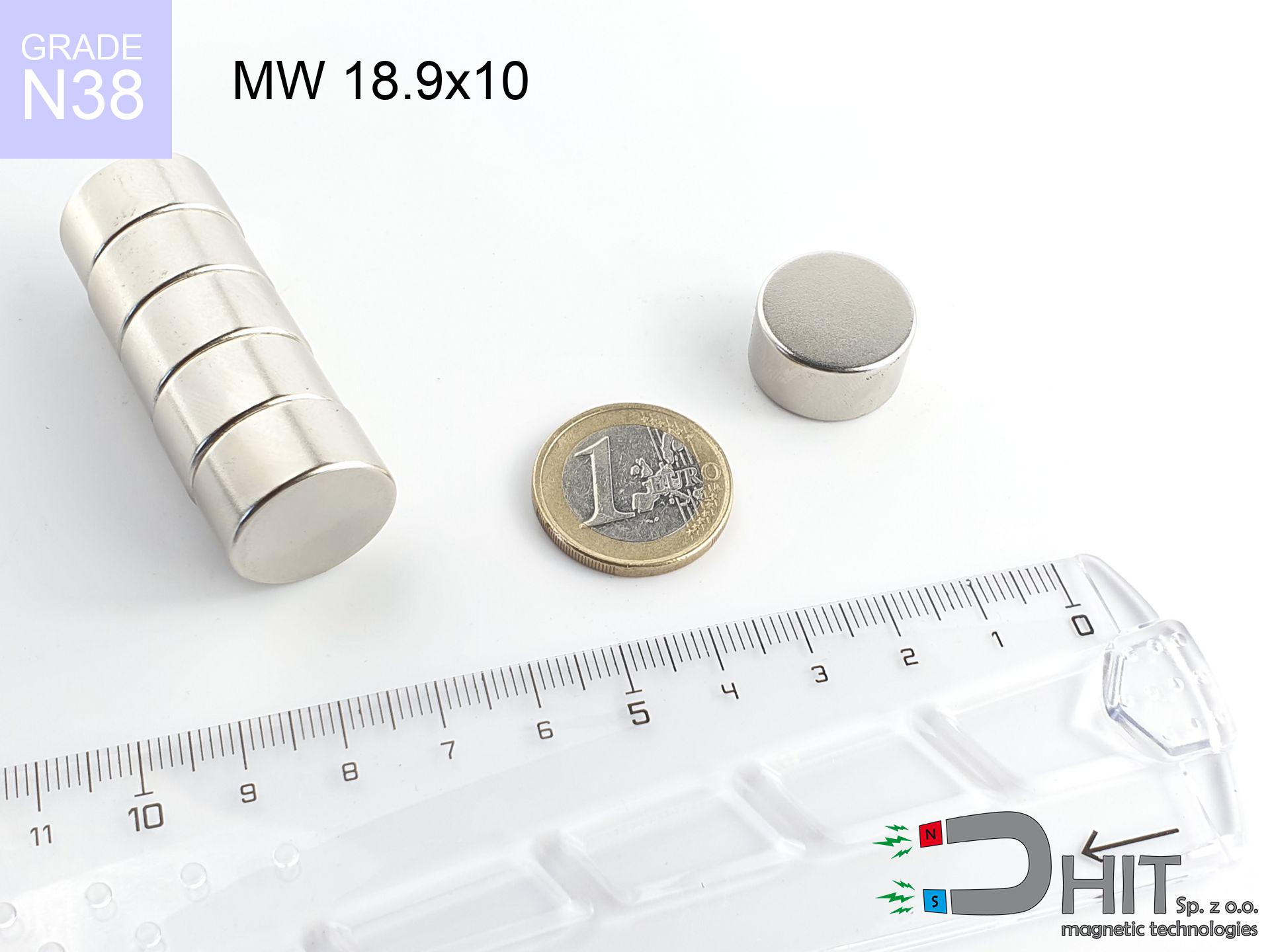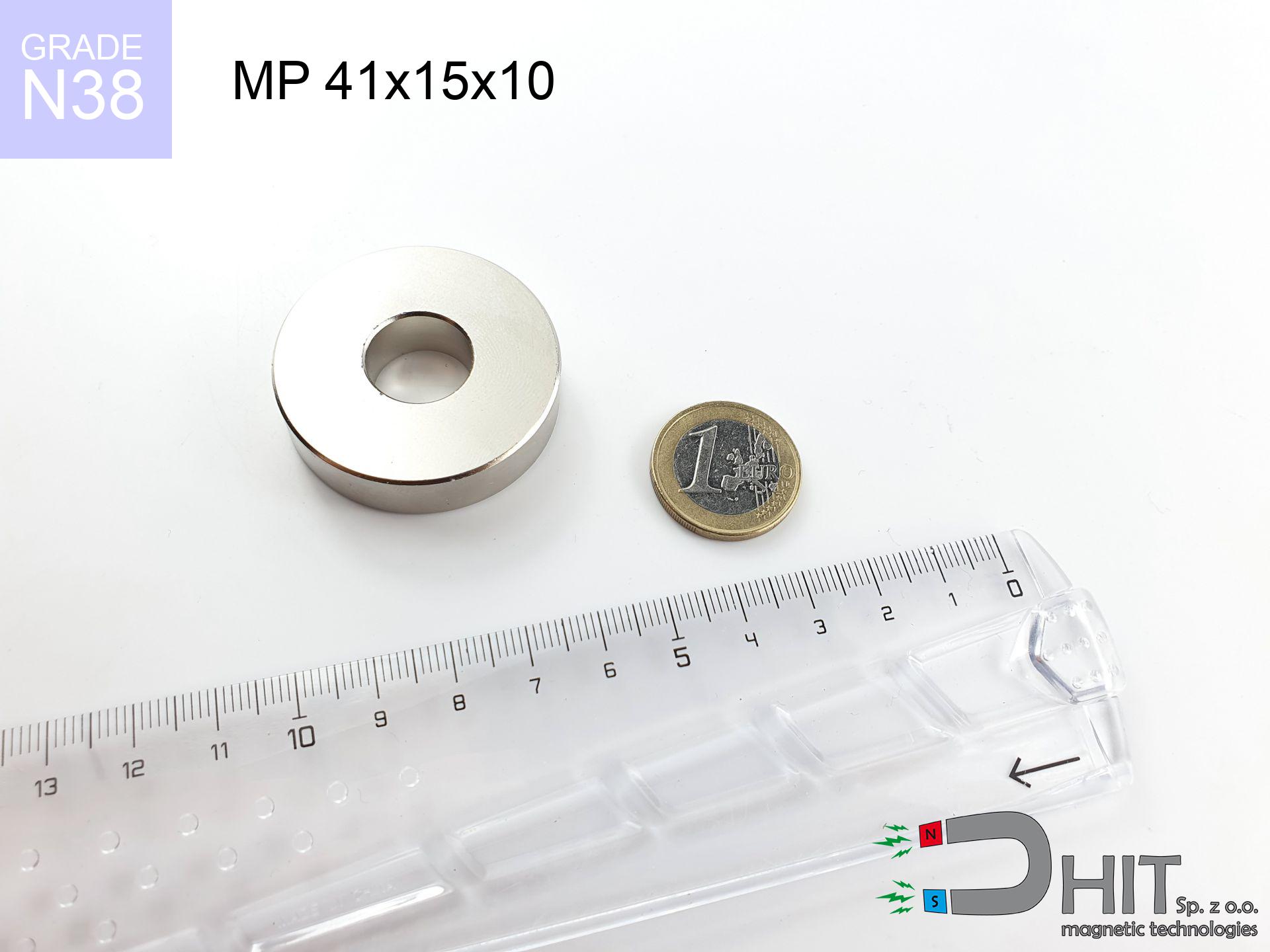MW 5x7 / N38 - cylindrical magnet
cylindrical magnet
Catalog no 010090
GTIN: 5906301810896
Diameter Ø [±0,1 mm]
5 mm
Height [±0,1 mm]
7 mm
Weight
1.03 g
Magnetization Direction
↑ axial
Load capacity
1.94 kg / 19.02 N
Magnetic Induction
582.40 mT
Coating
[NiCuNi] nickel
0.726 ZŁ with VAT / pcs + price for transport
0.590 ZŁ net + 23% VAT / pcs
bulk discounts:
Need more?Not sure which magnet to buy?
Call us
+48 22 499 98 98
otherwise contact us using
inquiry form
our website.
Lifting power and shape of neodymium magnets can be verified with our
force calculator.
Orders submitted before 14:00 will be dispatched today!
Magnetic properties of material N38
Physical properties of sintered neodymium magnets Nd2Fe14B at 20°C
Shopping tips
Strengths as well as weaknesses of NdFeB magnets.
Apart from their notable magnetic energy, neodymium magnets have these key benefits:
- They virtually do not lose power, because even after 10 years the decline in efficiency is only ~1% (in laboratory conditions),
- Neodymium magnets remain exceptionally resistant to demagnetization caused by magnetic disturbances,
- By covering with a lustrous layer of nickel, the element presents an proper look,
- Magnetic induction on the top side of the magnet turns out to be extremely intense,
- Made from properly selected components, these magnets show impressive resistance to high heat, enabling them to function (depending on their shape) at temperatures up to 230°C and above...
- Thanks to versatility in designing and the capacity to modify to client solutions,
- Wide application in advanced technology sectors – they are used in data components, drive modules, precision medical tools, as well as industrial machines.
- Compactness – despite small sizes they offer powerful magnetic field, making them ideal for precision applications
Disadvantages of neodymium magnets:
- Brittleness is one of their disadvantages. Upon intense impact they can fracture. We advise keeping them in a steel housing, which not only secures them against impacts but also raises their durability
- Neodymium magnets decrease their power under the influence of heating. As soon as 80°C is exceeded, many of them start losing their force. Therefore, we recommend our special magnets marked [AH], which maintain stability even at temperatures up to 230°C
- They oxidize in a humid environment - during use outdoors we advise using waterproof magnets e.g. in rubber, plastic
- Due to limitations in realizing nuts and complex shapes in magnets, we propose using casing - magnetic mechanism.
- Health risk to health – tiny shards of magnets pose a threat, if swallowed, which is particularly important in the aspect of protecting the youngest. It is also worth noting that tiny parts of these devices are able to be problematic in diagnostics medical after entering the body.
- Due to expensive raw materials, their price exceeds standard values,
Maximum lifting force for a neodymium magnet – what affects it?
The load parameter shown refers to the peak performance, measured under optimal environment, namely:
- using a plate made of high-permeability steel, acting as a circuit closing element
- whose thickness reaches at least 10 mm
- with an ideally smooth touching surface
- with zero gap (no coatings)
- for force applied at a right angle (in the magnet axis)
- at room temperature
Lifting capacity in practice – influencing factors
During everyday use, the real power depends on many variables, ranked from most significant:
- Distance – the presence of any layer (rust, dirt, air) interrupts the magnetic circuit, which reduces capacity rapidly (even by 50% at 0.5 mm).
- Pull-off angle – remember that the magnet holds strongest perpendicularly. Under shear forces, the capacity drops drastically, often to levels of 20-30% of the maximum value.
- Base massiveness – insufficiently thick plate does not accept the full field, causing part of the flux to be escaped into the air.
- Chemical composition of the base – mild steel gives the best results. Alloy steels reduce magnetic properties and lifting capacity.
- Smoothness – ideal contact is obtained only on polished steel. Any scratches and bumps reduce the real contact area, reducing force.
- Heat – NdFeB sinters have a negative temperature coefficient. When it is hot they are weaker, and in frost gain strength (up to a certain limit).
* Holding force was checked on a smooth steel plate of 20 mm thickness, when the force acted perpendicularly, however under shearing force the load capacity is reduced by as much as fivefold. Additionally, even a small distance {between} the magnet and the plate lowers the holding force.
Warnings
Dust explosion hazard
Dust generated during grinding of magnets is self-igniting. Do not drill into magnets unless you are an expert.
Conscious usage
Use magnets consciously. Their huge power can surprise even professionals. Stay alert and do not underestimate their power.
Nickel coating and allergies
Certain individuals experience a hypersensitivity to Ni, which is the typical protective layer for NdFeB magnets. Extended handling can result in skin redness. We strongly advise wear safety gloves.
Keep away from computers
Avoid bringing magnets near a wallet, computer, or screen. The magnetism can irreversibly ruin these devices and erase data from cards.
Danger to pacemakers
People with a heart stimulator have to maintain an large gap from magnets. The magnetism can interfere with the operation of the life-saving device.
Demagnetization risk
Control the heat. Exposing the magnet above 80 degrees Celsius will ruin its magnetic structure and pulling force.
Magnetic interference
A powerful magnetic field negatively affects the operation of magnetometers in phones and navigation systems. Do not bring magnets near a smartphone to prevent breaking the sensors.
Fragile material
Neodymium magnets are sintered ceramics, meaning they are very brittle. Collision of two magnets will cause them shattering into shards.
Bodily injuries
Risk of injury: The attraction force is so great that it can cause hematomas, crushing, and even bone fractures. Use thick gloves.
Swallowing risk
Neodymium magnets are not intended for children. Swallowing multiple magnets can lead to them attracting across intestines, which constitutes a direct threat to life and necessitates urgent medical intervention.
Important!
Looking for details? Read our article: Why are neodymium magnets dangerous?






![BM 510x180x70 [4x M8] - magnetic beam BM 510x180x70 [4x M8] - magnetic beam](https://cdn3.dhit.pl/graphics/products/bm-510x180x70-4x-m8-cem.jpg)
![UMH 75x18x68 [M8] / N38 - magnetic holder with hook UMH 75x18x68 [M8] / N38 - magnetic holder with hook](https://cdn3.dhit.pl/graphics/products/umh-75x18x68-m8-wag.jpg)

